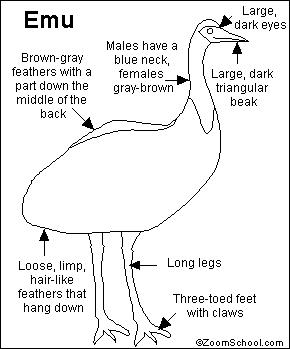
 |
| You might also like: | Kookaburra Printout | Ringtail Possum Printout | Wallaby Printout | Oryx Printout | Nutria Printout | Today's featured page: Keel-Billed Toucan Read-and-Answer Quiz |
| More Information on Birds | EnchantedLearning.com Emu | Animal Printouts Label Me! Printouts |


This huge bird lives in flocks (groups) in grasslands, savannas (grasslands with some trees), and the Australian bush. The emu's life span is 10-20 years. The genus and species of the emu are Dromaius novaehollandiae.
Anatomy: Emus grow to be about 6 feet (185 cm) tall and weigh about 110 pounds (50 kg). This is bigger than many adult humans.
Reproduction: The emu's nest is a shallow hole by a bush; it is lined with leaves, grass, and bark. The female lays from 4 to 20 greenish-brown eggs in a clutch (a group of eggs laid at one time). Chicks (baby emus) hatch after an incubation period of about 8 weeks. The male incubates (keeps warm) the eggs and cares for the chicks for about 1 1/2 years.
Diet: Emus are primarily herbivores (plant-eaters). They eat grass, seeds, flowers, young plants, and fruit. They also eat some insects (including caterpillars). They swallow small stones (called gastroliths or gizzard stones) which stay in the gizzard and help grind up food.
| Search the Enchanted Learning website for: |